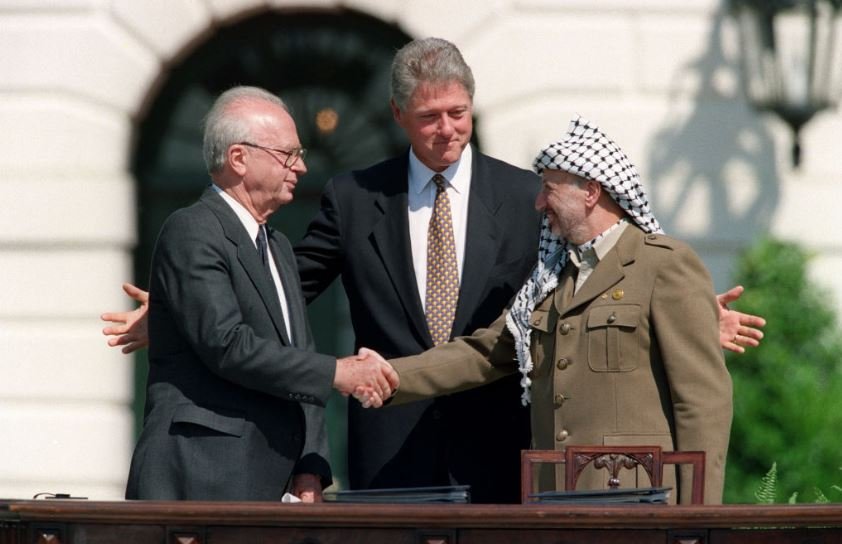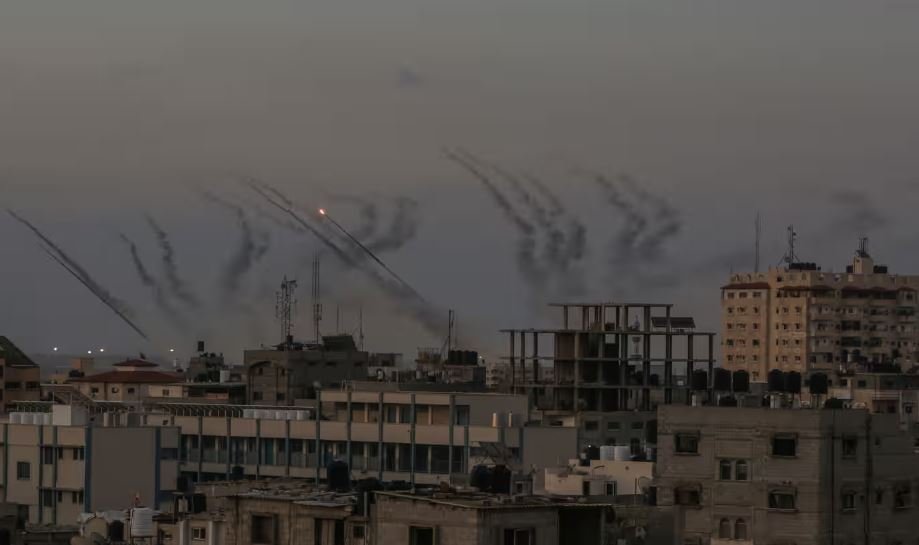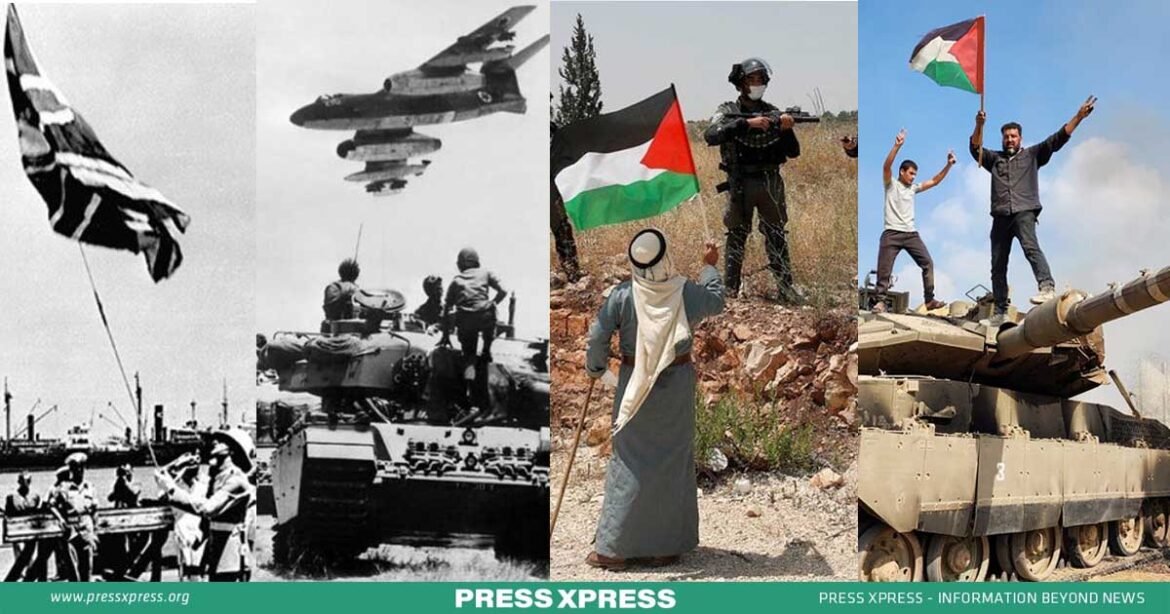From Egyptian military governance to Israeli occupation, the emergence of Hamas, the elusive promise of statehood, and cycles of violence, this narrow strip of land along the Mediterranean has endured immense challenges.
The end of British colonial rule in Palestine in 1948 marked the beginning of a tumultuous era in the region’s history. As tensions escalated between Jews and Arabs, the birth of the State of Israel and the ensuing Arab-Israeli War in May 1948 set in motion a series of events that continue to shape the complex narrative of the Gaza Strip.
Initially, the Gaza Strip fell under Egyptian military governance in the 1950s and 1960s. The influx of Palestinian refugees and the enduring Israeli presence fueled Palestinian discontent. Then, in 1967, Israel took control of Gaza, further altering the region’s dynamics. The emergence of Hamas in 1987 during the first Palestinian intifada added another layer of complexity. The Oslo Accords in 1993 offered a glimmer of hope for Palestinian self-governance, but the promise of statehood remained elusive, contributing to subsequent conflicts, including the Second Palestinian Intifada in 2000.
You can also read: Hamas Launches Deadliest Offensive on Israel
The situation in Gaza took a dramatic turn in 2005 when Israel withdrew its settlements, followed by the election victory of Hamas in 2006. Isolation, economic challenges, and a cycle of hostilities persisted, culminating in a surprise attack by Hamas in 2023.
The Gaza Strip’s history is a mosaic of struggles, aspirations, and conflicts, reflecting the broader complexities of the Israeli-Palestinian conflict. This ongoing saga is a testament to the resilience and challenges faced by the people living in this narrow strip of land along the Mediterranean.
British Colonial Rule Came to an End (1948)
As British colonial rule came to a close in Palestine in the late 1940s, violence escalated between Jews and Arabs, leading to a war between the newly established State of Israel and its Arab neighbors in May 1948. Tens of thousands of Palestinians sought refuge in Gaza after fleeing or being displaced from their homes. The invading Egyptian army had taken control of a narrow coastal strip 40 kilometers long (25 miles long), extending from the Sinai to just south of Ashkelon. The influx of refugees resulted in Gaza’s population growing threefold to approximately 200,000.

Egyptian Military Governance (1950s & 1960s)
Egypt maintained control over the Gaza Strip for two decades under a military governor, allowing Palestinians to work and study in Egypt. Armed Palestinian fedayeen, many of whom were refugees, carried out attacks on Israel, prompting retaliatory actions. The United Nations established a refugee agency, UNRWA, which currently offers services to 1.6 million registered Palestinian refugees in Gaza, as well as to Palestinians in Jordan, Lebanon, Syria, and the West Bank.
War and Israeli Military Occupation (1967)
In 1967, during the Middle East war, Israel took control of the Gaza Strip. A census conducted by Israel in that same year reported a population of 394,000 in Gaza, with at least 60% of the residents being refugees.

As the Egyptian presence ended, a significant number of Gazan laborers found employment in the agriculture, construction, and service sectors within Israel, benefiting from the relatively easy access they had at the time. Israeli forces continued to govern the region and safeguard the settlements constructed by Israel in the subsequent decades, which gradually fueled Palestinian discontent.
Palestine’s Initial Rebellion Started by Hamas (1987)
Twenty years after the 1967 war, the first Palestinian intifada, also known as an uprising, was initiated. This uprising commenced in December 1987 following a traffic accident in which an Israeli truck collided with a vehicle carrying Palestinian workers in Gaza’s Jabalya refugee camp, resulting in the tragic deaths of four individuals. Consequently, stone-throwing protests, strikes, and shutdowns ensued.
Taking advantage of the prevailing anger, the Egypt-based Muslim Brotherhood established an armed Palestinian entity in the form of Hamas, with its primary influence centered in Gaza. Hamas, firmly committed to the destruction of Israel and the reestablishment of Islamic governance in what it viewed as occupied Palestine, emerged as a competitor to Yasser Arafat’s secular Fatah party, which led the Palestine Liberation Organization.
The Oslo Accords, and Palestinian Semi-autonomy (1993)
In 1993, a historic peace accord was signed between Israel and the Palestinians, resulting in the establishment of the Palestinian Authority. This interim agreement granted Palestinians initial authority in Gaza and Jericho in the West Bank. Following decades in exile, Arafat returned to Gaza.

The Oslo process afforded the newly formed Palestinian Authority a degree of autonomy and anticipated statehood within five years. Regrettably, this goal was never realized. Israel accused the Palestinians of violating security agreements, while continued Israeli settlement construction further inflamed Palestinian sentiments.
Second Palestinian Intifada (2000)
In the year 2000, Israeli-Palestinian relations hit a new low point when the second Palestinian intifada erupted. This period brought about a series of suicide bombings and shooting attacks by Palestinians, as well as Israeli airstrikes, demolitions, establishment of no-go zones, and imposition of curfews.
Among the victims of this conflict was Gaza International Airport, a symbol representing dashed Palestinian hopes for economic self-sufficiency and the sole Palestinian link to the outside world not under Israeli or Egyptian control. Opened in 1998, Israel considered it a security threat and destroyed its radar antenna and runway shortly after the September 11, 2001, attacks in the United States.

Another casualty was Gaza’s fishing industry, which served as a livelihood for tens of thousands. Israel enforced restrictions on Gaza’s fishing zone, citing the need to prevent the smuggling of weapons.
Israel Evacuates Its Gaza Settlements (2005)
In August 2005, Israel withdrew all its military personnel and settlers from Gaza, which had been completely enclosed by Israeli barriers by that time.
The Palestinians dismantled the deserted structures and infrastructure to salvage materials. The evacuation of the settlements resulted in increased mobility within Gaza, and a “tunnel economy” flourished as armed factions, smugglers, and businesspeople promptly excavated numerous tunnels connecting to Egypt.

Isolation Under Hamas (2006)
In 2006, Hamas achieved an unexpected victory in Palestinian parliamentary elections and subsequently gained full control of Gaza by overthrowing forces loyal to Arafat’s successor, President Mahmoud Abbas.
Due to their classification of Hamas as a terrorist organization by the US and their allies, many members of the international community reduced their aid to Palestinians in Hamas-controlled areas.

Israel prevented tens of thousands of Palestinian workers from entering the country, cutting off a significant source of income. Israeli airstrikes also caused widespread blackouts by damaging Gaza’s sole electrical power plant. In response to security concerns, Israel and Egypt tightened their restrictions on the movement of people and goods through the Gaza crossings.
Conflict spiral
The cycle of hostilities, assaults, and reprisals between Israel and Palestinian armed group has frequently hurt Gaza’s economy.
Before 2023, some of the deadliest combat occurred in 2014 when Hamas and other organizations fired rockets into Israeli cities located in the country’s center. Israel bombarded Gaza with artillery and aircraft that completely destroyed entire neighborhoods. Over 2,100 Palestinians were killed, the majority of them were civilians. Six civilians and 67 troops were listed as the number of Israeli fatalities.
Hamas’s Surprise attack
On Saturday (7th October 2023), Hamas fighters carried out an unexpected assault on Israel, causing havoc in towns, resulting in hundreds of casualties, and capturing dozens of hostages whom they took to Gaza. In retaliation, Israel launched airstrikes on Gaza, leading to the destruction of entire neighborhoods in one of the bloodiest incidents in the 75-year-long conflict. More than 1,055 individuals have lost their lives in Gaza, Palestine, and over 5,183 people have sustained injuries in the ongoing conflict between Palestine and Israel in Gaza.

Conclusion
The history of the Gaza Strip is a turbulent tale of hope and despair, shaped by the aftermath of British colonial rule in 1948. From Egyptian military governance to Israeli occupation, the emergence of Hamas, the elusive promise of statehood, and cycles of violence, this narrow strip of land along the Mediterranean has endured immense challenges. The latest shocking attack by Hamas in 2023 stands as a grim reminder of the ongoing complexities in the Israeli-Palestinian conflict. Gaza’s story is a testament to the resilience and suffering of its people, reflecting the broader regional dynamics that continue to shape its fate.


